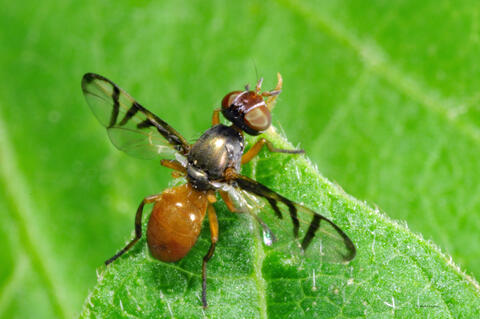Bug’s Eye View
Soybean Nodule Fly Vol. 9, No. 14

Rivellia quadrifasciata
Order: Diptera
Family: Platystomatidae
Take a deep breath before you read further. …….... The air you just inhaled is around 21% oxygen and 78% nitrogen. These are both diatomic molecules, meaning each oxygen atom is joined to another oxygen atom with a strong double bond, and each nitrogen atom is joined to another nitrogen atom with an even stronger triple bond. The hemoglobin in your blood just grabbed some of those O2 molecules to carry into your body. They will be put to good use.
The N2 molecules were just along for the ride as you breathed in and out. At normal temperatures N2 is an inert gas because the triple bond that holds the two Ns together is hard to break. Commercial fertilizer factories must use high temperatures and a lot of energy to convert atmospheric nitrogen to ammonia.
But some plants can convert atmospheric nitrogen into ammonia at normal temperatures. Legume plants such as peas and beans have little bumps on their roots called nodules, which form through a symbiotic relationship with special bacteria, Bradyrhizobium spp. The bacteria inside these nodules “fix nitrogen” using an enzyme called nitrogenase to break the triple bond of N2 and convert it into ammonia, a form of nitrogen plants can use.
Next time you are in your garden, dig up a pea or bean plant and carefully shake the soil from the roots to see if they have nodules. Use a sharp knife to cut into some of the larger nodules and they will probably be pink inside due to the leghemoglobin they contain. Leghemoglobin does not fix nitrogen; its role is to remove free oxygen molecules and prevent them from interfering with the nitrogen fixing process, which requires an oxygen free environment. Each of those nodules is a miniature nitrogen fertilizer factory, a sustainable source of nitrogen in a nitrogen hungry world. Can’t have proteins without nitrogen.
What does all this have to do with insects? Soybean nodule flies are so named because their larvae eat the nitrogen-fixing nodules of soybeans and other legumes. They feed on roots as well, but nodules are an important part of the diet of older larvae. Fortunately, populations are usually low and there is rarely cause for concern about nitrogen deficiency due to excessive nodule damage. Still, it is noteworthy that there are insects that specialize in feeding on the nitrogen-fixing nodules of legumes, and soybean nodule flies are not alone. Bean leaf beetle larvae also feed on the nodules of beans, peas, and other legumes.
Despite their name, soybean nodule flies are native insects. Before soybeans and cowpeas were brought into the country, they occurred on beggar lice, Desmodium spp. and other native legumes.
Next time you are in your garden, keep an eye out for soybean nodule flies. These little flies are only about 1/5 inch long, but their reddish orange color makes them relatively easy to spot as they are resting on a leaf. You probably won’t see many, but if there are cowpeas or beans in the garden, there will likely be a few soybean nodule flies.
Blake Layton, Extension Entomology Specialist, Mississippi State University Extension Service.
The information given here is for educational purposes only. Always read and follow current label directions. Specific commercial products are mentioned as examples only and reference to specific products or trade names is made with the understanding that no discrimination is intended to other products that may also be suitable and appropriately labeled.
Bug’s Eye View is now on Facebook. Join the Bug's Eye View Facebook group here.